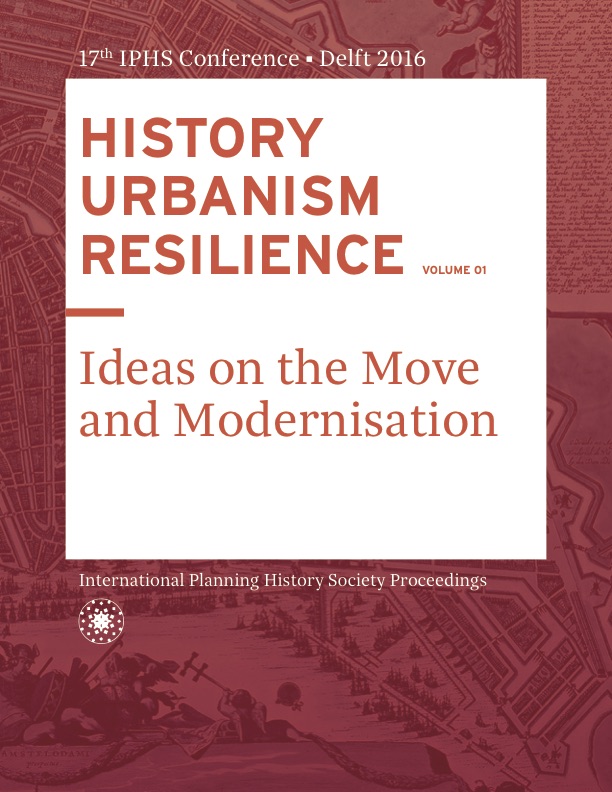The Diplomatic Quarters in Riyadh. A Western-shaped neighborhood in an Islamic city.
DOI:
https://doi.org/10.7480/iphs.2016.1.1213Abstract
Riyadh, the capital of the Kingdom of Saudi Arabia, is a complex relatively young city. One of its major districts was built ex-novo only 30 years ago as part of a governmental input to define Riyadh as capital of the Kingdom. Albert Speer III and Partners thus designed the Diplomatic Quarters (DQ) as an enclave built in a major spot on the Valley Hanifa, nearby the first Riyadh settlement called Al Dirriyah. The urban landscape has been recognized for being well integrated with both the valley and the deserted landscape. In addition, the DQ’s major core could be considered a prototype of the New Urbanism Theory. The DQ was designed to be accessible to all citizens, but early 2000 terrorist attacks forced the DQ management to close its fences and made this place only accessible for tenants and temporary visitors. However, it has become a major district for scholars to define Riyadhs’ identity.Through a design process analysis, and primary observation methodologies, this paper aims to answer the following questions: why is the DQ becoming an identity spot for scholars and citizens? How is this space been interpreted by scholars to make it part of Riyadh’s identity discourse? How has this space been preserved and used by its inhabitants, both locals and foreigners?
The paper analyses the DQ’s urban planning by highlighting the elements that leads to the interpretation of identity, such as landscape integration, district configuration or the Major Core’s urban spaces and typologies. The paper will question the validity of the identity discourse, and will show the DQ challenges facing Riyadh’s conservative society. Finally, this paper expects to raise awareness on the need to rethink from a historical perspective a main district in one of the fastest growing cities in the world.
References
Abdelsalam. T. “Courtyard housing in Saudi Arabia: in search of a contemporary typology,” in Edwards B.; Sibley, M.; Hakmi, M. and Land, P. (eds.), Courtyard housing. Past, present & future. Abingdon: Taylor & Francis, 2006, p. 203-210.
Abu-Lughod, J.L. “The Islamic City – Historic myth, Islamic essence and contemporary relevance,” in International Journal of Middle East Studies, 19, 2 (1987): 155-176.
Al-Hatloul, S. & Mughal, M. “Creating identity in new communities: Case studies from Saudi Arabia,” in Landscape and Urban Planning, 44 (1999):199-218.
Al-Hatloul, S. & Mughal, M. “Urban growth management – The Saudi experience,” in Habitat International, 28, (2004): 609-623.
Al-Hemaidi, W. K. “The metamorphosis of the urban fabric in Arab-Muslim city: Riyadh, Saudi Arabia,” in Journal of Housing and the Built Environment, 16, 2 (2001): 179-201.
Al-Naim, M. “Identity in transitional context: open-ended local architecture in Saudi Arabia”, in International Journal of Architectural Research, 2, 2, (2008a):125-146.
Al-Naim, M. “Riyadh: a city of ‘institutional’ architecture,” in Elsheshtawy, Y. (ed.),The evolving Arab city. Tradition, modernity and urban development. New York: Routledge, (2008b), 118-151.
Alqahtany, A.; Rezgui, Y. & Li, H. “A concensus-based framework for the sustainable urban planning development: “as an approach for Saudi Arab cities”,” in International Journal of Environmental Science and Development, 5, 2, (2014).
Alshaikh, A.; Othman, Z. & Ward, G. “The Diplomatic Quarter and Ministry of Foreign Affairs staff housing project” in http://archnet.org/system/publications/contents/3078/original/dpc0395.pdf?1384770838 (1986)
Babsail M.O. & Al-Qawasmi, J.“Vernacular architecture in Saudi Arabia: Revival of displaced traditions, ” in Vernacular architecture: Towards a Sustainable Future: proceedings of the International Conference on Vernacular Heritage, Sustainability and Earthen Architecture, Valencia, Spain, 11-13 September 2014, 99-104.
Bahammam, O.S. “The role of privacy in the design of the Saudi Arabian courtyard house,” in Edwards B.; Sibley, M.; Hakmi, M. and Land, P. (eds.), Courtyard housing. Past, present & future. Abingdon: Taylor & Francis, 2006, 77-82.
Garba, S.B. “Managing urban growth and development in the Riyadh metropolitan area, Saudi Arabia,” in Habitat International, 28 (2004): 593-608.
Gonzalez, M. “The translation of a house typology: Riyadh and the suburban house,” in Translation Connect, 1, 3, (2016): 54-56.
Ishteeaque, E.M. & Al-Said, F.A. The native architecture of Saudi Arabia, architecture and identity. Riyadh: Riyadh municipality, 2008.
Le Renard, A. A Society of Young Women. Opportunities of Place, Power and Reform in Sadui Arabia Standford: Standford University Press, 2014.
Menoret, P. Joyriding in Riyadh. Oil, urbanism and road revolt. Cambridge: Cambridge University Press, 2014. Kindle edition.
Middletone, D.A. Growth and expansion in post-war urban design strategies: C.A. Doxiadis and the first strategic plan for Riyadh Saudi Arabia (1968-1972). (PhD diss. Georgia Institute of Technology, 2009).
Neglia, G.A. “Some historiographical notes on the Islamic city with particular reference to the visual representation of the built city,” in Jayyusi, S.K.(general editor), The city in the Islamic World, vol. 1. Boston: Brill, 2008, 3-46.
Radoine, H., “Planning paradigm in the madina: order in randomness,” in Planning Perspectives, 26, 4 (2011): 527-549.
Raymond, A. “The spatial organization of the city,” in Jayyusi, S.K.(general editor), The city in the Islamic World, vol. 1. Boston: Brill, 2008, 47-70.
Salam, A.A. “Population and household census, Kingdom of Saudi Arabia 2010: facts and figures,” in International Journal of Humanities and Social Science, 3, 16 (2013): 258-263.
Saleh, M. A. E. “Place identity: the visual image of Saudi Arabian cities,” in Habitat International, 22, 2, (1998): 149-164.
Saleh, M. A. E. “The changing image of Arriyadh city: the role of socio-cultural and religious traditions in image transformation,” in Cities, 10, (2001): 315-330.
Saleh, M. A. E. “Learning from tradition: the planning of residential neighbourhoods in a changing world,” in Habitat International, 28, (2004): 625-639.
The Aga Khan Award for Architecture, Al Kindy Plaza nomination booklet. Accessed on December 2014 http://www.akdn.org/architecture/pdf/0920_sau.pdf
Sobh,R. & Belk, R. “Domains of privacy and hospitality in Arab gulf homes, “ Journal of Islamic Marketing 2, 2, (2011): 125 – 137. doi: http://dx.doi.org/10.1108/17590831111139848

